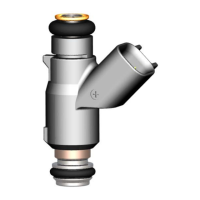Software Multec 3.5 Fuel Injector Application Manual
5-18
Delphi Energy and Chassis Systems
Revision: 11/05-1
5.3.2 Oxygen Sensor Diagnostics
The signal of an oxygen sensor normally swings up and down between
about 0.8 and 0.2 volts one or more times every second. A condition of
mal-distribution can cause the pre-converter oxygen sensor to oscillate at
the frequency of the engine (RPM). If the oxygen sensor oscillates above
a certain limit, the Malfunction Indicator Lamp will illuminate and a
diagnostic trouble code will be stored in the engine controller. Other
potential oxygen sensor failure modes include: high sensor voltage output,
low sensor voltage output, or no activity detected.
Note
Consult the oxygen sensor applications manual for additional details.
5.3.3 Catalytic Converter Diagnostics
The oscillation of the oxygen sensors can also determine if the catalytic
converter is working properly. The signal of the pre-converter oxygen
sensor normally swings up and down between about 0.8 and 0.2 volts one
or more times every second. When the converter is warmed up and
operating correctly, the signal from the sensor behind the converter will
switch over very slowly. It is not unusual for the signal from this sensor
to stay at either high voltage (greater than 0.8 volts) or a low voltage (less
than 0.2 volts) once the converter is at operating temperature. When it
switches between high and low at a rate and amplitude similar to the pre-
converter sensor, this can be an indication of a faulty catalytic converter.
5.3.4 Injector Driver Diagnostics
By looking at current flow to the injector, this diagnostic ensures that
engine controller injector drivers, injectors, and wiring harnesses are
working properly.
5.3.5 Engine Misfire Diagnostics
An excessive rich or lean shift of an injector may cause a rich or lean
air/fuel ratio that is either non-combustible or very weak. This can
ultimately result in engine misfires. Diagnostics detect engine misfires
that exceed a predetermined percentage of combustion events. Engine
misfire can be detected through crankshaft deceleration or ion sensing in
the combustion chamber using the ignition circuit. Engine calibration
engineers should determine what air/fuel ratio causes the onset of misfires,
and calibrate diagnostics to recognize the fuel flow condition that causes
misfiring.
Note
Rich or lean injectors are not the only potential cause of misfires. Other
potential causes could be: base engine, ignition system, etc.

